Experience the ultimate family fly fishing adventure!
Blue Safari Fly Fishing Seychelles invites all families to join us for a fishing adventure of a lifetime. If you book a full-board fly fishing experience, your children 17 years and under can stay for FREE and are only charged for the fly fishing package and flights. Join us between June and October 2025 and experience some of the worlds best flats fishing with your loved ones making memories for life.
Enquire Now
The top saltwater fish to fly fish

Best fish to fly fish in the Seychelles Islands
The remote islands of the Alphonse Group in the Seychelles, off the East Coast of Africa, is both isolated and teeming with extraordinary pelagic species. A worthy challenge for any fly fisherman worth his or her salt.
Established on Alphonse Island, the Alphonse Fishing Co™ gives guests premier access to Alphonse and St. François Atolls, Astove Atoll, Poivre Atoll, Farquhar Atoll and Cosmoledo Atoll. The atolls offer a combination of wadeable flats, shallow clear lagoons and sheer drop-offs which create exhilarating saltwater fly fishing experiences.
Equipped with a full team of expert guides and skippers, superior boats, top of the range equipment and a strict catch-and-release policy, Alphonse Island also guarantees professional game fishing like no other.
Largely protected, the Seychelles outer islands are home to some of the most exquisite and aggressive predatory fish species of the oceans.
Giant trevally on a fly
(Caranx ignobilis)
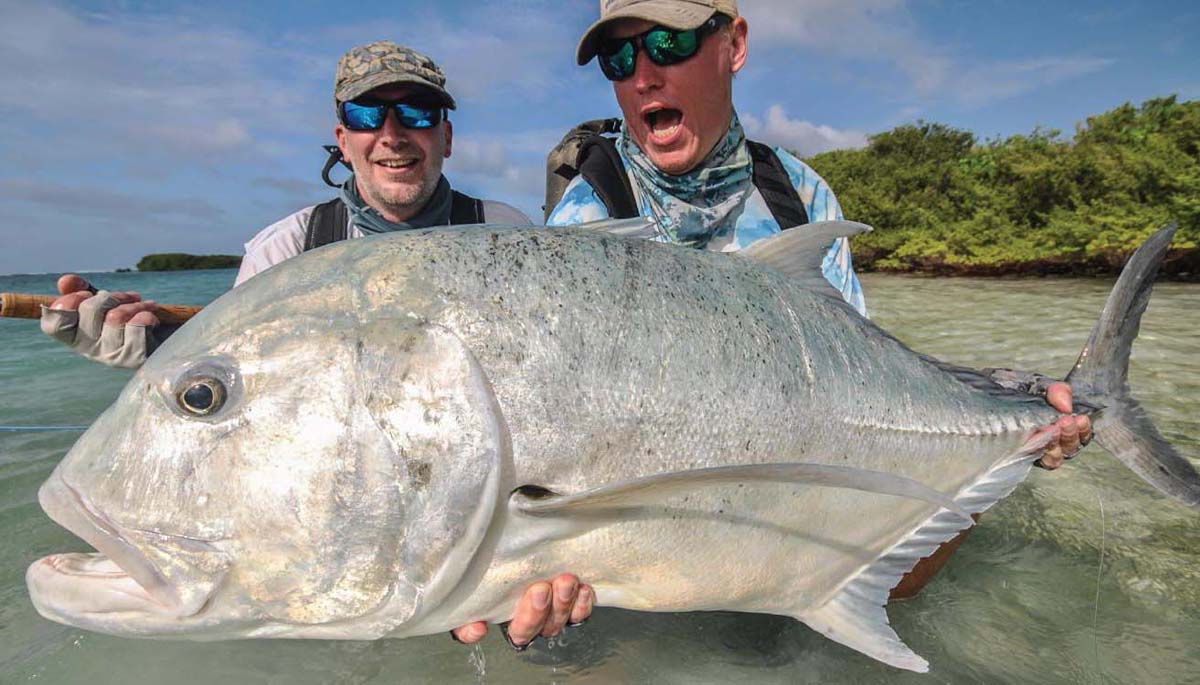 Image: Huge GT caught a fly at Cosmoledo
Image: Huge GT caught a fly at Cosmoledo
A super predator that is found at all our destinations in good numbers with specimens as large as 120lbs. Cosmoledo is considered the GT capital of the world with more GT’s caught here than anywhere else in the world. Where Cosmoledo holds larger numbers of GT’s, Astove is known to hold larger specimens. Alphonse also holds a healthy number of GT’s which are on average larger than those found at Cosmoledo. This apex predator can be found hunting in the deep waters of the atoll lagoons as well as shallow flats.
Find out everything you need to know about fly fishing for giant trevally here.
Moustache triggerfish on a fly
(Balistoides viridescens)
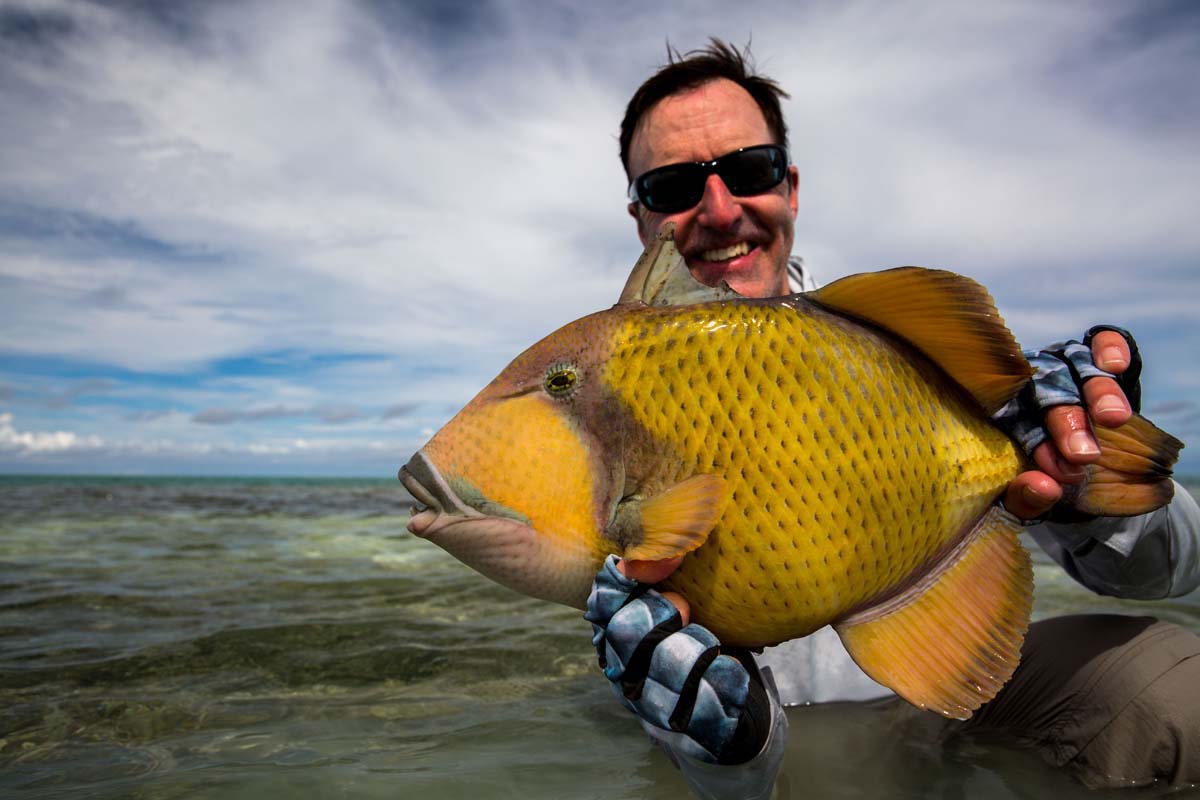 Image: Moustache triggerfish caught on a fly at Alphonse Island.
Image: Moustache triggerfish caught on a fly at Alphonse Island.
This colourful and energetic species can be spotted (and targeted) while feeding in the shallows, both on the flats and the reef edges. Known as a giant, titan or moustache triggerfish, it is the largest of the three species that can be caught in similar numbers at Alphonse, Astove and Cosmoledo. Alphonse guides were the first to develop the flies and techniques to catch these feisty fish, as well as to introduce triggerfish as a much sought-after trophy for flats fishermen.
Find out everything you need to know about fly fishing for triggerfish here.
Yellowmargin triggerfish on a fly
(Pseudobalistes flavimarginatus)
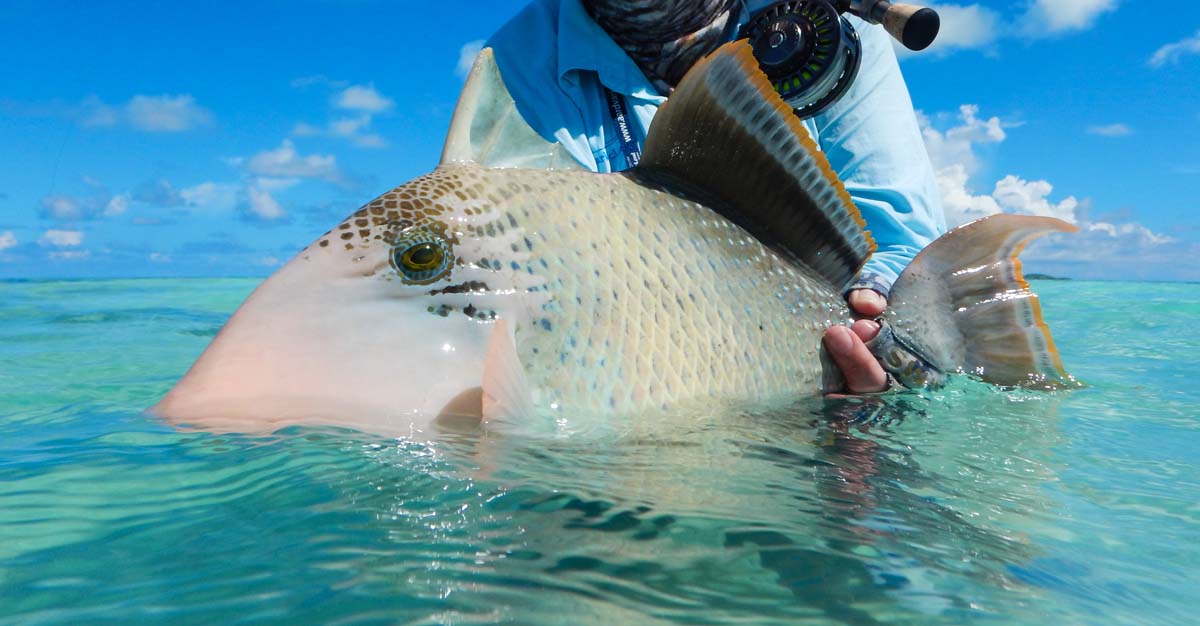 Image: Yellowmargin triggerfish caught on a fly at Alphonse Island.
Image: Yellowmargin triggerfish caught on a fly at Alphonse Island.
Triggerfish are opportunists, feeding mainly on small crustaceans which makes them perfect targets on the fly. The atolls of Alphonse, Astove and Cosmoledo offer equal opportunities when it comes to targeting yellowmargin triggerfish. These colourful characters have extended anal- and dorsal fins that work in conjunction with each other but in different directions, giving them incredible acceleration. yellowmargin triggerfish can weigh up to 15lbs and reach lengths of 60cm.
Find out everything you need to know about fly fishing for triggerfish here.
Indo-Pacific permit on a fly
(Trachinotus blochii)
Image: Permit caught on a fly with Alphonse Fishing Co. guide.
Also known as Pompano, the Indo-Pacific permit is a member of the Carangid family and a relative of the Atlantic permit. A trip with Alphonse Fishing Co™ will prove optimal if you’re targeting this golden-edged beauty as Astove, Alphonse and Cosmoledo all hold good populations of permit. Found at both Alphonse and St. François Atolls, Astove also holds a large population within its shallow lagoon and Cosmoledo holds slightly less but larger specimens. These shimmering carnivores can reach a meter in length and weigh up to 35lbs.
Find out everything you need to know about fly fishing for Indo-Pacific permit here.
Milkfish on a fly
(Chanos chanos)
 Image: Milkfish on a fly with Alphonse Fishing Co.
Image: Milkfish on a fly with Alphonse Fishing Co.
This finicky algae feeder and ferocious aerobatic fighter reach lengths of up to 180cm and can weigh over 50lbs. The Alphonse guides were the first to develop the flies and technique to lure in these fork-tailed devils; in fact, the first milkfish caught on fly was at Alphonse and the St. François Lagoon. With more milkfish caught here than anywhere else, Alphonse is the best destination in the world for this species. These large-eyed beauties can often be spotted in small pods with their tails protruding, both on the flats and offshore at all of our fishing destinations.
Find out everything you need to know about fly fishing for milkfish here.
Dogtooth tuna on a fly
(Gymnosarda unicolor)
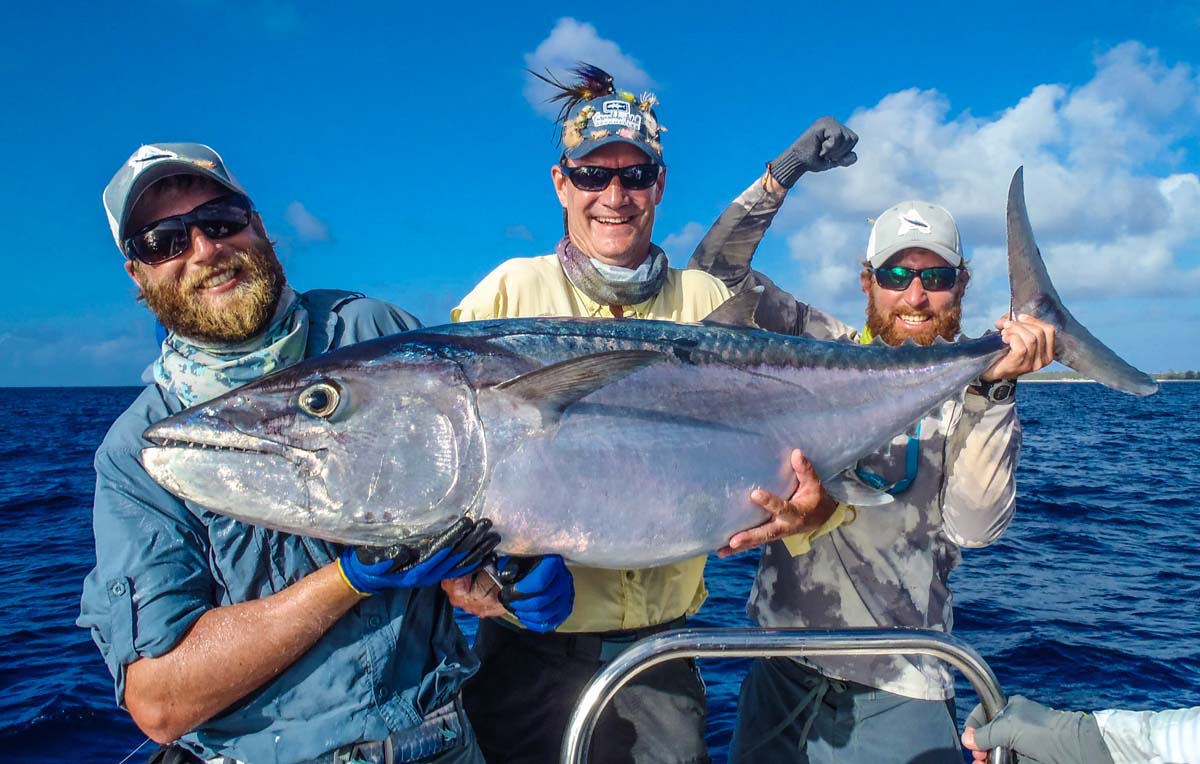 Image: Dogtooth tuna caught on a fly at Alphonse Island.
Image: Dogtooth tuna caught on a fly at Alphonse Island.
Dogtooth tuna is a resident-pelagic fish that are found along the drop-offs in good numbers at Alphonse, Astove and Cosmoledo. They patrol continental shelf drop-offs and frequent depths of up to 150ft, which are found relatively close to shore around these atolls. Astove and Cosmoledo have larger populations than Alphonse, with specimens as large as 250lbs caught on fly in previous years. These streamline hunters with their characteristic teeth are best targeted in clear, blue waters off the drop-offs where they hunt.
Indo-Pacific sailfish on a fly
(Istiophorus platypterus)
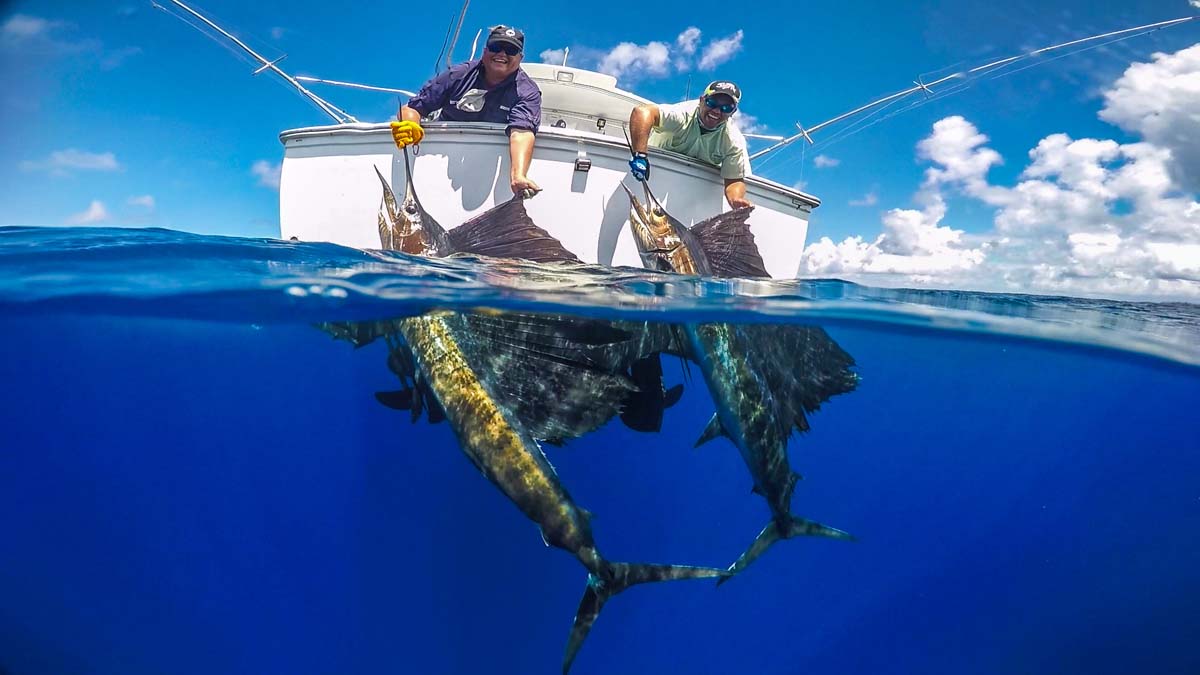 Image: Alphonse guide holding Sailfish caught at Alphonse Island.
Image: Alphonse guide holding Sailfish caught at Alphonse Island.
The Sailfish is one of the faster fish in the sea and named after its large dorsal fin which extends most of the length of its body. As the fastest fish in the ocean, these agile predators can reach speeds of up to 110km/h weigh up to 60lbs. Although Alphonse holds the largest population and is best equipped to tease and target these acrobatic fighters with the correct game boats and bluewater teams, they are found at all of our Alphonse Fishing Co™ destinations.
Find out everything you need to know about fly fishing for sailfish here.
Wahoo on a fly
(Acanthocybium solandri)
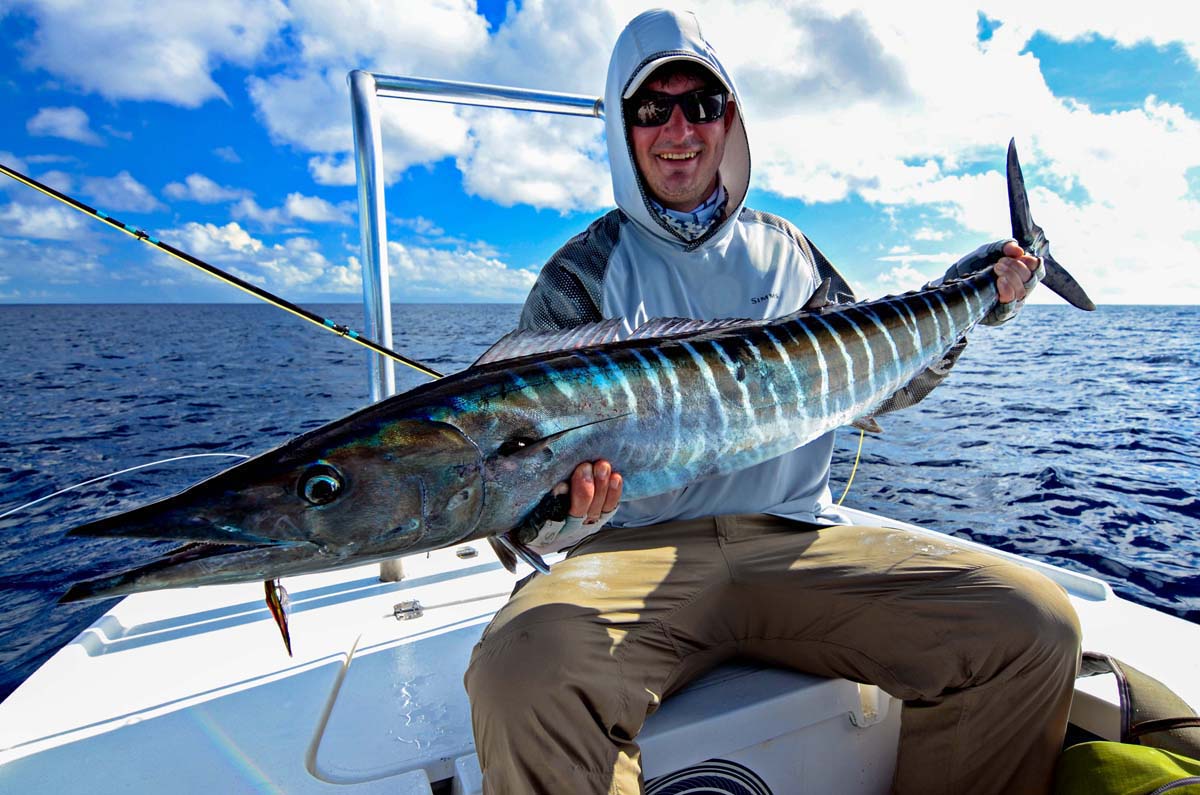 Image: Wahoo caught on a fly at Alphonse Island.
Image: Wahoo caught on a fly at Alphonse Island.
The Seychelles waters are known for their incredible numbers of wahoo due to the rich currents that flow close to the atolls. Reaching speeds of up to 80 km/h, the wahoo is the third fastest fish in the sea. Alphonse, Astove and Cosmoledo have very similar numbers of fish that range between 10 to 50lbs. These elongated predators can often be spotted hunting schools of baitfish.
Find out everything you need to know about fly fishing for wahoo here.
Barracuda on a fly
(Sphyraena barracuda)
 Image: Barracuda on a fly at Alphonse Island.
Image: Barracuda on a fly at Alphonse Island.
This fierce ambush predator is distinguishable by its cylindrical body and known to jump when hooked. Putting up a good fight, these fearsome-looking creatures are extremely fast and grow to over 240cm. Although all of our destinations hold great numbers of Barracuda, the largest specimens are caught at Alphonse due to the large population of bonefish which they hunt on the flats.
Find out everything you need to know about fly fishing for barracuda here.
Bonefish on a fly
(Albula vulpes)
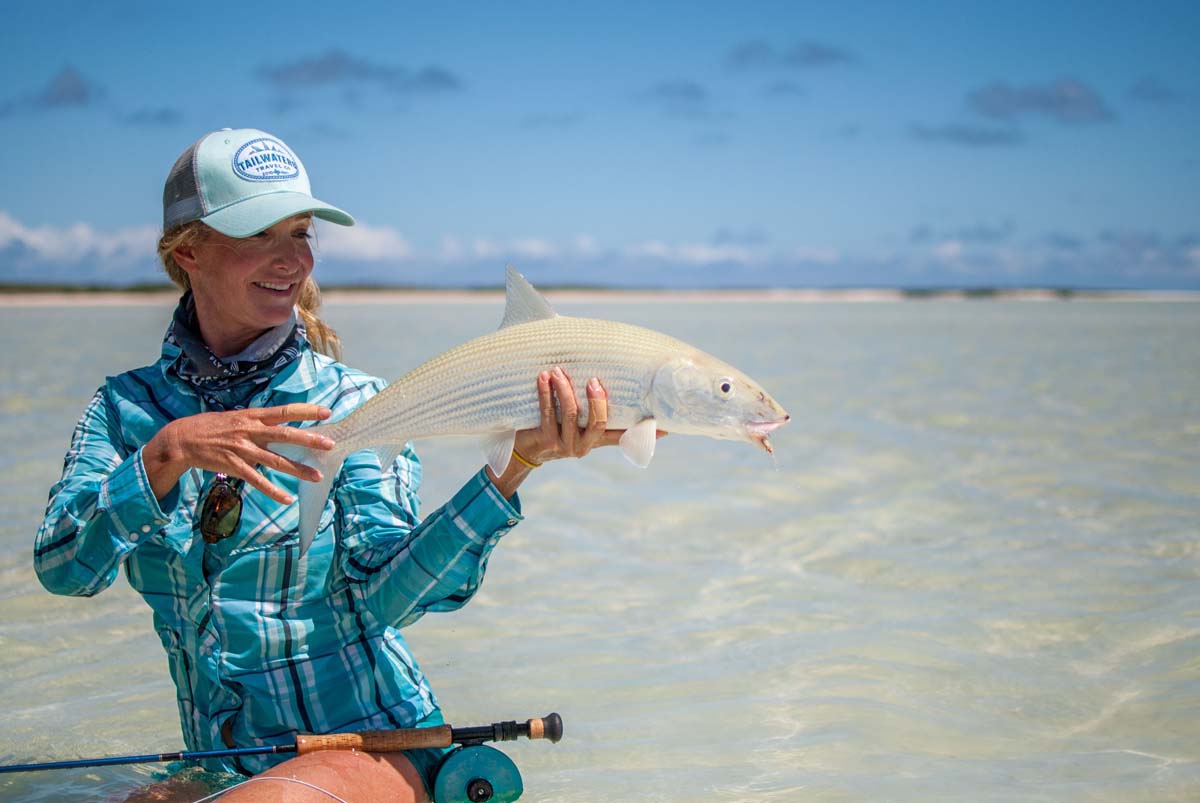 Image: Bonefish on the fly at Alphonse Island.
Image: Bonefish on the fly at Alphonse Island.
Large populations of bonefish can be found as they frequent the flats at Alphonse, Astove and Cosmoledo atolls. Although Alphonse holds the largest population of bonefish in the Seychelles islands with specimens reaching up to 6lbs, Astove and Cosmoledo hold the larger fish reaching up to 9lbs. These silvery carnivores can reach speeds of up to 65km/h and lengths of up to 100cm.
Find out everything you need to know about fly fishing for bonefish here.
Bluefin trevally on a fly
(Caranx melampygus)
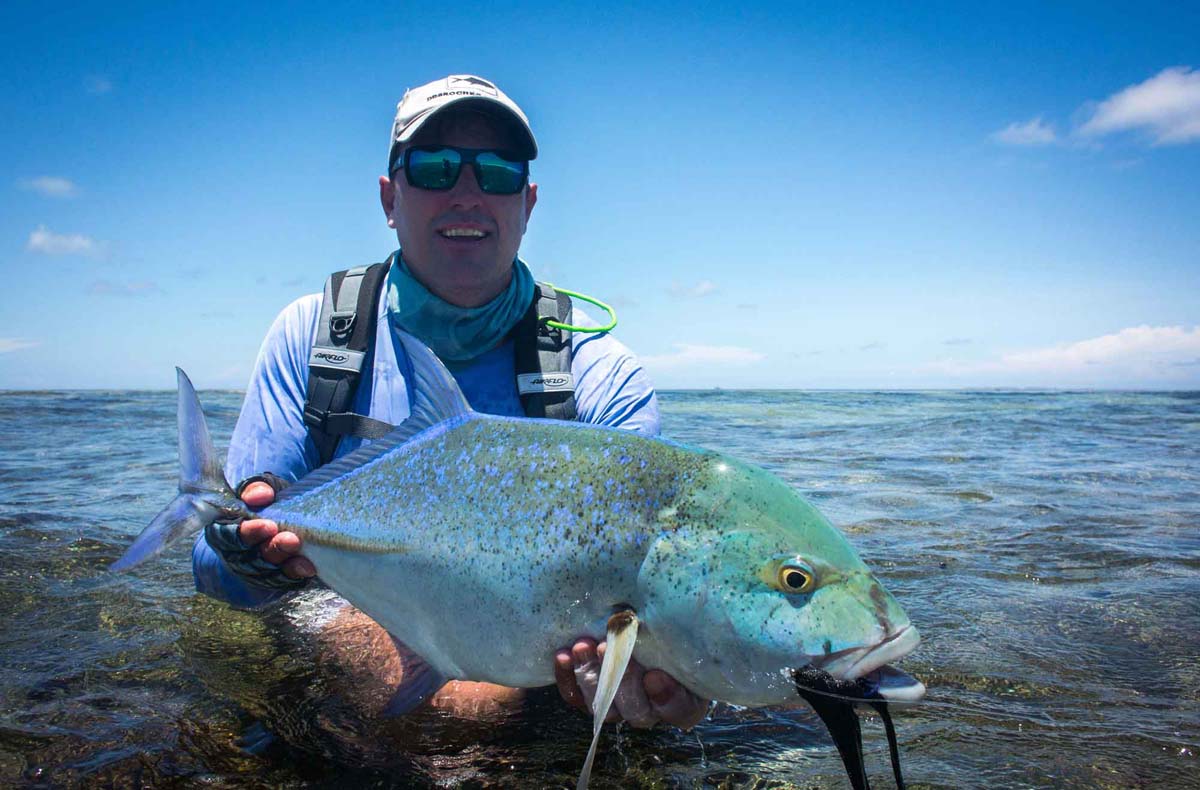 Image: Bluefin trevally caught on the fly at Cosmoledo Island.
Image: Bluefin trevally caught on the fly at Cosmoledo Island.
Bluefin trevallies are distributed throughout the tropical waters of the world with populations varying according to fishing pressure. The atolls of Alphonse, Astove and Cosmoledo are fully protected and also have shallow lagoons which support healthy populations of juveniles that contribute immensely to the overall population. These beautiful blue and yellow creatures can reach sizes of up to 80cm and weigh up to 88lbs. Best way to target these brightly coloured species is at the beginning of push tide in the surf.
Find out everything you need to know about fly fishing for bluefin trevally here.
Yellowfin tuna on a fly
(Thunnus albacares)
 Image: Yellowfin tuna caught on the fly at Alphonse Island.
Image: Yellowfin tuna caught on the fly at Alphonse Island.
These beautiful fish are among the larger of the tuna species and can reach a weight of up to 400lbs. Yellowfin tuna tends to follow their bait as they migrate through the Seychelles islands, thus all our destinations offer good numbers of this species. The best way to target these blue and yellow beauties are on a spring push tide when the water is clear. Alphonse Atoll is best set up with the correct game boats and bluewater teams to target these hard fighters.
Find out everything you need to know about fly fishing for yellowfin tuna here.
That brings us to the end of our list!
We hope you are inspired by our top fish to fly fish in the Indian Ocean. Make sure to get into contact with us should you have any questions.
For more inspiration on fly fishing species, have a look at our 39 Legendary Fish to Catch on the Fly Infographic.
EXPLORE OUR SALTWATER FLY FISHING DESTINATIONS
Join our fishing community
Join our community to get regular updates about our fishing adventures, guide updates and special offers.

